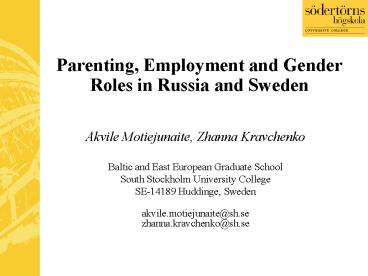Parenting, Employment and Gender Roles in Russia and Sweden - PowerPoint PPT Presentation
1 / 13
Title:
Parenting, Employment and Gender Roles in Russia and Sweden
Description:
... its orientation towards the involvement of the whole population of the working age into ... which encapsulates the normative aspects of gender role ... – PowerPoint PPT presentation
Number of Views:242
Avg rating:3.0/5.0
Title: Parenting, Employment and Gender Roles in Russia and Sweden
1
Parenting, Employment and Gender Roles in Russia
and Sweden
Akvile Motiejunaite, Zhanna Kravchenko Baltic
and East European Graduate SchoolSouth Stockholm
University College SE-14189 Huddinge,
Sweden akvile.motiejunaite_at_sh.se zhanna.kravchenk
o_at_sh.se
2
- Gender effects of family policy
- Womens decision to participate/or not on the
labour market is shaped by - institutional framework of social policy,
- social norms on redistribution of work/care
duties.
Research question What are the patterns of
relations between a) family policy
arrangements b) normative gender relations
c) actual family practices?
3
Sweden and Russia
- Similarities
- Wide participation of women in the labour market
- Female of the labour force (2004, The World
Bank data) - Russian Federation 49
- Sweden 47
- Explicit family policy aimed at conciliation of
waged work and care duties
- and Differences
- Sustainable democratic development in Sweden
- Drastic transformation of social, political,
economic order in Russia during the 1990s
4
Questions
- Do similarities in the approach and the
instruments of family policy result in similar
socio-economic practices of families? - How does the change in vector of economic and
political system influence the transformation of
gender-role attitudes?
5
Gender contract
- is a compromise made about the gender division
of labour, at work, and by implication, at home
(Gottfried 2000 253)
- official contract
- everyday contract
- ideal contract
6
Gender contracts in the worlds of welfareHow
the principles of structuring and design of
policies allow both women and men access to
public benefits and services?
The strong male-breadwinner model The male-breadwinner /female carer model
The modified male-breadwinner model The dual-earner/female part-time carer model
The weak male-breadwinner model (Lewis, 1992) The dual-earner/state carer model The dual earner-mercerised carer model The dual earner/dual carer model (Crompton, 1999)
7
Data
- documents and statistical indicators related to
the public authoritys policy as regards creation
of conditions for women engaging in wage labour
(and less thoroughly, for encouraging men to
participate in care) ? official contract - survey data, obtained from the International
Social Survey Programme (ISSP) on Family and
Changing Gender Roles, modules II and III (for
the years 1994 and 2002) ? ideal and everyday
contracts
8
The Official Contract
- The weak male-breadwinner model
- The state-carer model?
- Woman a worker and a carer
- Transformation of the official contract during
1994-2002 - Sweden no drastic changes in the model
- Russia towards the modified male-breadwinner
model
9
The Ideal Contract
- Factor analysis
- Scale Traditional Male Breadwinner Model (TMBM)
- All in all, family life suffers when the woman
has a full-time job. - A pre-school child is likely to suffer if his or
her mother works. - A mans job is to earn money a womans job is to
look after the home and family. - A job is all right, but what most women really
want is a home and children. - Being a housewife is just as fulfilling as
working for pay.
2002
1994
10
Determinants of support for TMBM (standard errors
within parentheses)
Notes significant at 0.05 level,
significant at 0.01 level.
11
The Ideal vs. the Everyday Contract
- Ideal Do you think that women should work
outside the home full-time, part-time or not at
all under these circumstances? - Everyday Did you work outside the home
full-time, part-time, or not at all...? OR What
about your spouse/partner at that time - did he
or she work outside the home full-time,
part-time, or not at all...? - After marrying and before there are children.
- When there is a child under school age.
- After the youngest child starts school.
- After the children leave home.
12
Pearson Correlation Coefficients between the
ideal and everyday contract
Notes significant at 0.05 level,
significant at 0.01 level. Pair-wise deletion
of missing values, N varies.
13
Conclusions
- Official contract the dual-earner/state
carer family model, but Sweden - emphasis on
dual-caring and flexible work arrangements for
women. - Ideal contract
- Sweden strong support for liberal family roles
increased, closer to official - Russia uniform agreement to TMBM decreased,
contradicts to official - Everyday contract more consistent with ideal
and official in Sweden, huge discrepancies in
Russia ? no choice































